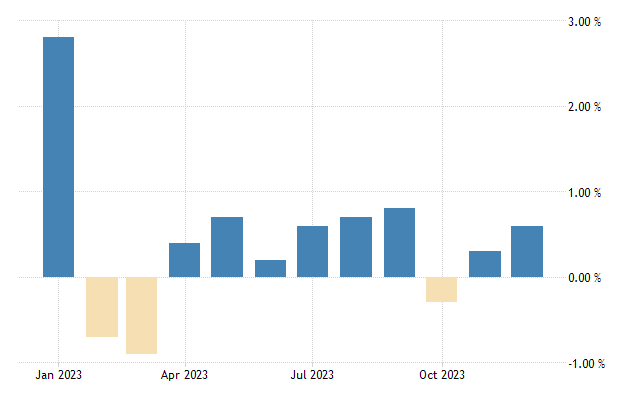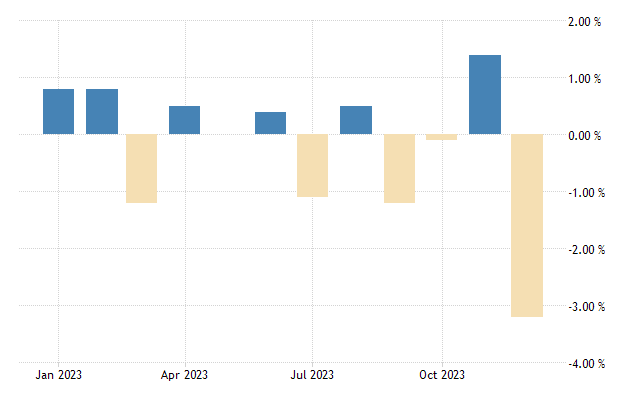As investors gear up for the upcoming Retail Sales data releases in the United States and the United Kingdom on February 15th and 16th, respectively, anticipation is high for insights into consumer spending trends. These releases serve as vital economic indicators, offering a glimpse into the pulse of consumer activity and broader economic conditions.
What to expect from US Retail Sales on February 15th
On Thursday, February 15th, all eyes will be on the US Retail Sales data, set to be released at 13:30 GMT. This highly anticipated release will provide crucial insights into the state of consumer spending, offering a glimpse into the health of the US economy.
Market expectations suggest a potential decline in Retail Sales for January, with an anticipated month-on-month (MoM) change of -0.1%. This contrasts with the previous month’s growth of 0.6%, indicating a potential slowdown in consumer activity.
When excluding auto sales, which can be volatile, the forecast remains relatively stable, with an expected MoM change of 0.2%. This aligns closely with the previous month’s figure of 0.6%, suggesting continued resilience in Retail Sales, albeit at a moderated pace.

The upcoming Retail Sales data release holds significant implications for Federal Reserve policymakers as they assess the trajectory of the US economy. Amidst concerns about inflation and its potential impact on consumer spending, the Fed’s decisions regarding interest rates are closely tied to economic data, including Retail Sales figures. Investors will closely analyse the data for clues about the economy’s resilience and potential implications for financial markets, so they can attempt to trade the news.
What to expect from UK Retail Sales on February 16th
On February 16th, at 8:00 GMT, market attention will turn to the release of UK Retail Sales data for January. Analysts are projecting a significant turnaround in Retail Sales figures for January, following a notable decline in the previous month.
For the month-on-month comparison, forecasts suggest a positive growth of 1.5% in total Retail Sales, a stark contrast to the previous month’s decrease of 3.2%. Similarly, Retail Sales excluding fuel are anticipated to show an increase of 1.7%, signalling a recovery from the previous month’s decline of 3.3%.

On a year-on-year basis, expectations remain cautious, with projected declines in both total Retail Sales and Retail Sales excluding fuel. Analysts foresee a year-on-year decrease of 1.4% for total Retail Sales and a slightly steeper decline of 1.6% for Retail Sales excluding fuel. These figures represent a slight improvement compared to the previous month’s year-on-year declines of 2.4% and 2.1%, respectively.
The anticipated uptick in Retail Sales comes amidst a week packed with crucial data releases in the UK, including Consumer Price Index (CPI) and Gross Domestic Product (GDP) figures, which can be found on an economic calendar. This dense schedule of economic indicators is expected to inject added volatility into the GBP, influencing currency markets and trading strategies.
Given the significance of consumer spending to the UK economy, the Retail Sales data holds particular importance for policymakers and investors. Any deviations from the expected figures could impact market sentiment and expectations regarding the Bank of England‘s monetary policy stance. With inflationary pressures and supply chain disruptions affecting consumer behaviour, the Retail Sales data will provide valuable insights into the resilience of the UK consumer and the broader economic recovery.
Understanding US and UK Retail Sales
US and UK Retail Sales data, compiled and reported monthly by the U.S. Census Bureau and the Office of National Statistics respectively, are a comprehensive view of consumer spending across various retail categories. These include clothing, electronics, groceries, and more. The figures play a crucial role as a key economic indicator, reflecting shifts in consumer sentiment, disposable income, and overall economic health.

Significance of US and UK Retail Sales
The significance of US and UK Retail Sales lies in their impact on economic activity, particularly their influence on the Gross Domestic Product (GDP). Strong Retail Sales typically signal a buoyant economy, indicating heightened consumer confidence and economic expansion. Conversely, declines in Retail Sales may signify economic challenges, potentially dampening overall economic growth.
Role in Financial Markets
Financial markets closely monitor Retail Sales data as they can sway investor sentiment and shape expectations for future economic performance. Analysts use these figures to gauge the strength of consumer spending trends, guiding forecasts for economic growth and market dynamics.